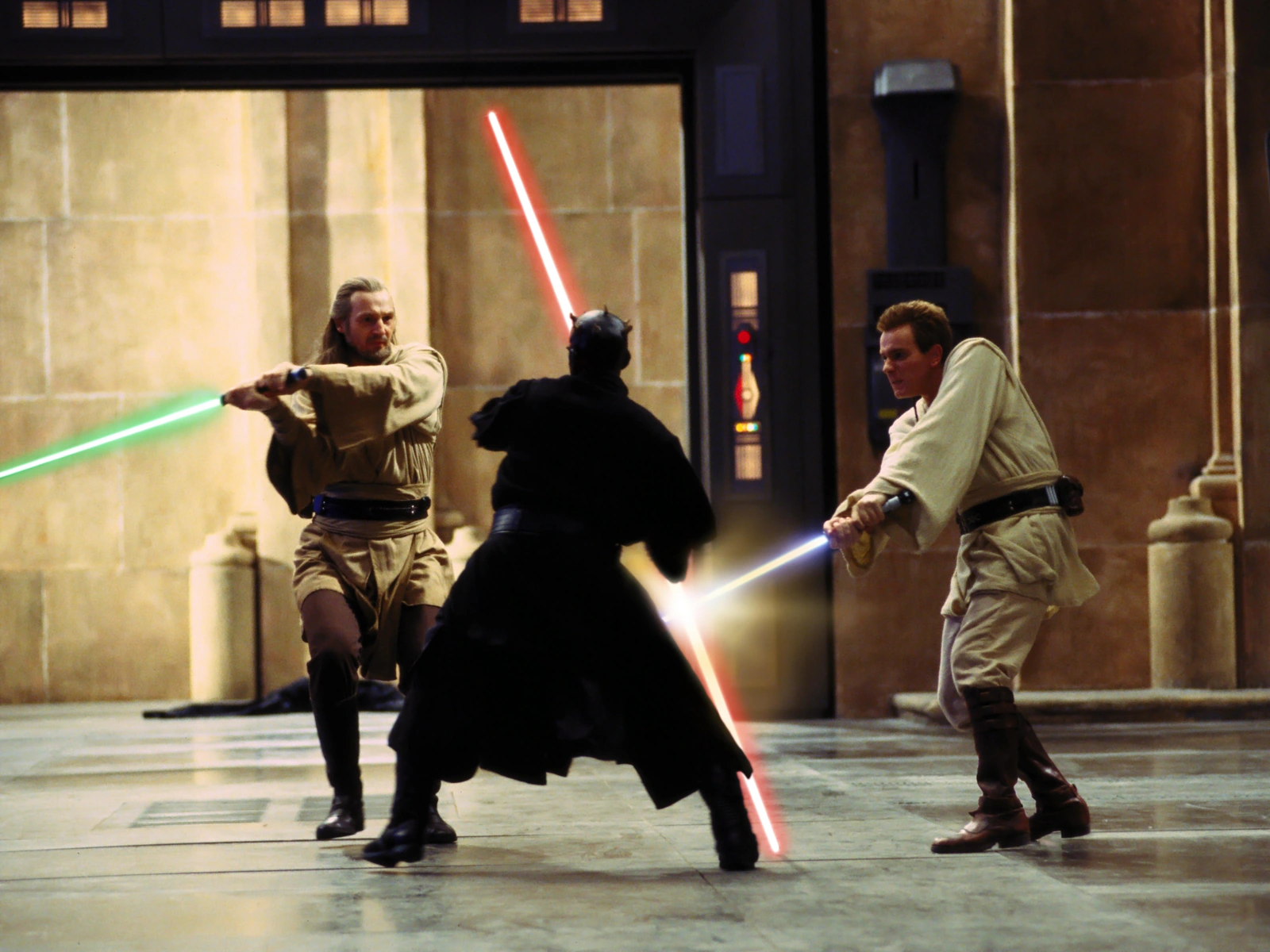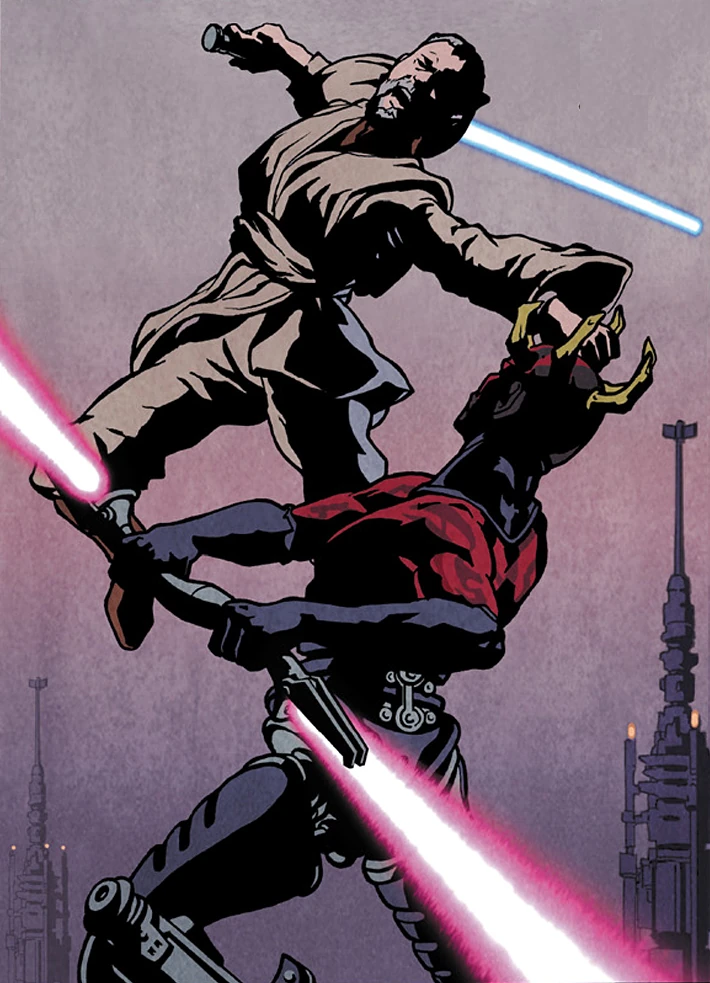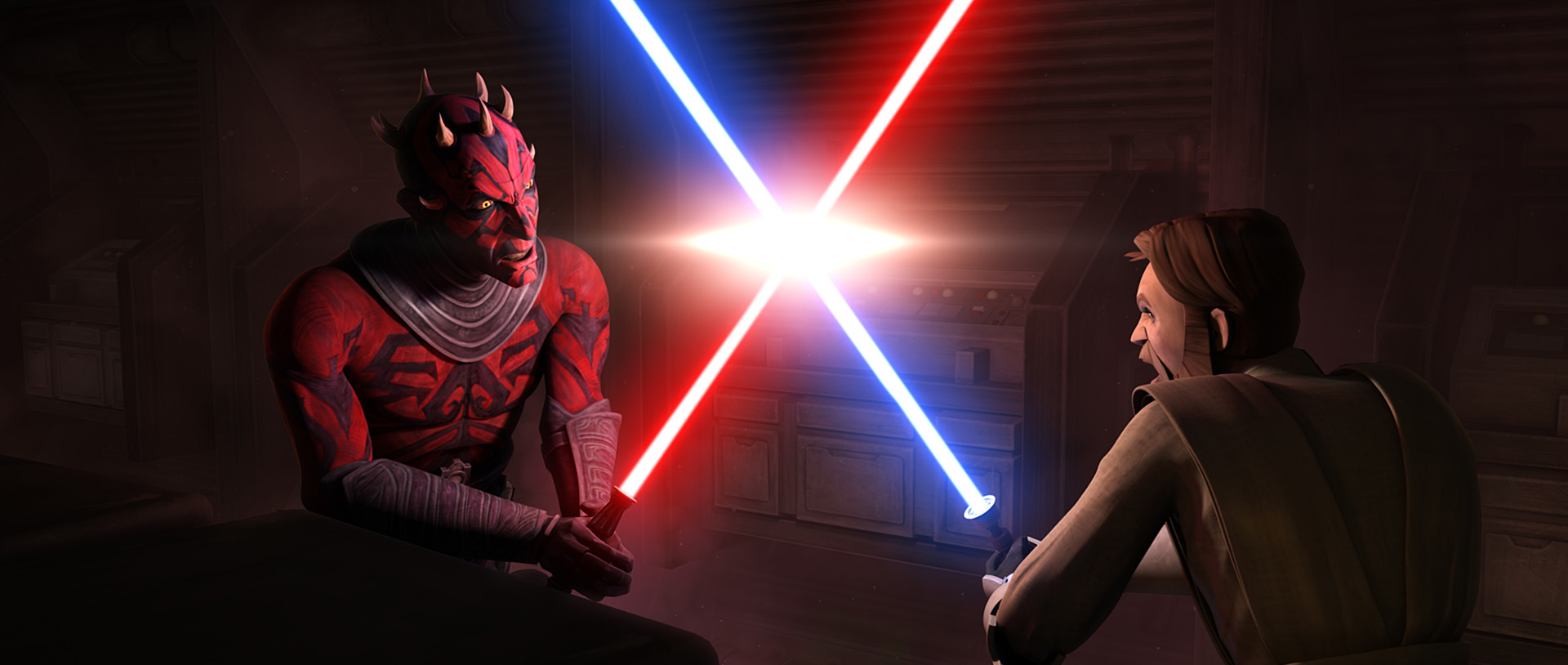The recent media storm surrounding the new crossguard lightsaber wielded by Kylo Ren in Star Wars: The Force Awakens may remind some internauts of a similar buzz that surrounded the introduction of another baddie in black. When Star Wars Episode I: The Phantom Menace came out in 1999, Darth Maul’s hugest (and unfortunately only) selling point was his own, unique double-bladed lightsaber.
In classic Star Wars fashion, the undoubtedly badass-looking Zabrak Sith apprentice met his end at the hands of Obi-Wan Kenobi and was eaten by the proverbial Sarlacc. In this act, Maul ascended to the pantheon of under-developed-yet-awesome Star Wars villains, just as his Mandalorian armor-clad predecessor had in 1983, and had audiences crying out for more.
Since his apparent death in the film, Maul has made appearances in several tie-in books, comics, and video games of varying levels of canonicity before being officially reintroduced to the galaxy in season four of The Clone Wars television show. Now he’s returning to the small screen once again in the epic hour-long season finale of Star Wars Rebels so, before we see him again, let’s explore just who is Darth Maul?

The shadowy and mysterious Sith apprentice was first introduced as a villain in Star Wars: Episode I The Phantom Menace. His iconic character design and menacing fighting style made him an instant success with audiences, who clamored for the character to return even after Obi-Wan Kenobi chopped him in half and threw him down a bottomless pit.
Described as “a figure from your worst nightmare” by George Lucas, Maul’s design is based on flayed flesh, tribal face-painting, and Rorschach patterning. Portrayed in the film by martial artist Ray Park, who used a combination of kenjutsu fighting styles, tennis swings, and tree chopping to bring his impressively choreographed character to life, Maul was a suitably menacing adversary to the Jedi. The character famously received only three spoken lines in the film, beating out Boba Fett, who had four lines in The Empire Strikes Back, for the least lines given to a major villain.
His character and backstory were eventually fleshed out in a series of comics and books that were released in the wake of the film, beginning with the novelization of the film itself, which featured a detailed passage outlining the history of the Sith. From there, Maul’s story would be picked up nearly a year later by a tie-in comic series penned by Ron Marz and titled Star Wars: Darth Maul, an adventure set before the events of the film featuring Maul battling the Black Sun crime syndicate. Maul’s apprenticeship under Darth Sidious is explored further in James Luceno’s 2001 short story “Darth Maul: Saboteur”, which featured Maul’s first solo mission for his master. This story was later published in tandem with Michael Reaves’ novel, Darth Maul: Shadow Hunter, which takes place on the eve of The Phantom Menace and features Maul’s first encounter with the Jedi. While all of this information is now considered Legends, its standing under the old rules for the Expanded Universe was just as precarious.
Relegated, like all tie-in materials, to the C-level of canon (continuity canon), the information revealed by Expanded Universe stories was subject to change if it didn’t fit with the story George Lucas wanted to tell. So, then, why is it important to dredge up these defunct storylines? The answer is two-fold.
First, under the new canon a lot of important information has been lost regarding the Sith and events that took place before The Phantom Menace. While this information will undoubtedly be fleshed out in the future, much of it will probably hew close to what has already been established or at least include elements of what’s come before. As Ahsoka Tano says in the season two trailer for Star Wars Rebels, “There’s always a bit of truth in legends.”
Second, Darth Maul is a veritable case-study in de-canonization and re-canonization; his character has been through many incarnations of varying degrees of canonicity and, in many ways, is emblematic of the storytelling overhaul done by the 2008 show Star Wars: The Clone Wars, a salvage effort the size of Dave Filoni’s hat. Before we move on to Maul’s reintroduction in Filoni’s show, I find it necessary to explore one last non-canon Darth Maul story.
Aaron McBride, an Industrial Light & Magic artist, wrote a short comic for a 2005 anthology titled Star Wars: Visionaries, which collected stories penned by artists who worked on Star Wars: Episode III Revenge of the Sith. The comic, titled Old Wounds, features a resurrected Maul with replacement bionic legs who hunts down Obi-Wan during his vigil on Tatooine in order to exact his revenge. This same concept, albeit earlier in both characters’ timeline, was later appropriated by George Lucas for the fourth season of Star Wars: The Clone Wars. This instance, along with George Lucas’ propensity for raiding certain elements of continuity canon while modifying others, demonstrates just how malleable canon has always been in this regard, with elements of different works of varying canonicity bleeding together to form a storytelling tapestry.
It is with this concept in mind that we must approach George Lucas and Dave Filoni’s show Star Wars: The Clone Wars, which left in its wake a confused and muddled timeline of events in its drive to completely supplant the previous Clone Wars transmedia project in favor of a stricter and more uniform canon, labelled then as T-canon.

In the three years between Star Wars: Episode II Attack of the Clones and Star Wars: Episode III Revenge of the Sith, Lucasfilm released a number of tie-in materials, including a television show, a series of video games, and a number of comics and books, as part of a transmedia project called the Clone Wars Multimedia Project, an effort to tell the story of the Clone Wars in real time between the release of the two final films of the trilogy.
The project saw the introduction of characters like Asajj Ventress and General Grievous while the relationship between Anakin Skywalker and Obi-Wan Kenobi was fleshed out in more detail. The story ended in 2005 with the release of the then-final Star Wars film. George Lucas decided to revisit the era in 2008 with the release of a new Clone Wars project centered around Dave Filoni’s flagship show Star Wars: The Clone Wars.
While the show used many of the characters introduced in the original transmedia project, it largely ignored the established timeline of events and made significant changes to other aspects of Expanded Universe canon. After the show proved itself to be successful and popular, Lucas decided to bring Darth Maul back to life in the finale episode of season four.
Maul’s story continued through season five, where he became the leader of an underworld crime organization called the Shadow Collective and exacted his revenge on Obi-Wan Kenobi by killing his former flame, Duchess Satine. Maul’s character design for this storyline was lifted straight from the Old Wounds comic and his original Expanded Universe backstory was scrapped in favor of a connection with Mother Talzin and the Nightsisters.
In the 2014 Dark Horse canon miniseries Star Wars: Darth Maul—Son of Dathomir, which was adapted from scripts for the unfinished sixth season of The Clone Wars, it is established that Darth Maul is, in fact, the son of Mother Talzin, stolen from his home by Darth Sidious to be trained as a Sith. This seemed to be the last we heard from Maul until the rumor mill started working for the second season of Star Wars Rebels.

As the second half of Star Wars Rebels season two loomed in the horizon, the internet was abuzz with rumors about Darth Maul’s involvement in the future of the franchise. While much of the focus surrounded his involvement in the animated television show itself, another bit of interesting news popped up near the end of 2015. The video game company Red Fly Studio had been working with LucasArts on a Darth Maul lightsaber combat game called Battle of the Sith Lords prior to Disney’s acquisition of Lucasfilm in 2012 and, like other projects at the time, the game was scrapped to make way for the new Star Wars trilogy.
In October of 2015, the developers conducted a Reddit AMA about the game and encouraged people to post on social media in support of resurrecting the game. Whether or not the game will be picked up is another story entirely but the public’s continued interest in Maul’s fate is reflective of the character’s enduring popularity.
Darth Maul will be officially returning to Star Wars canon in the finale episode of this season of Star Wars Rebels, an hour-long special titled “Twilight of the Apprentice”, in which our heroes Ezra, Kanan, and Ahsoka travel to Malachor to uncover the secret of Darth Vader. Like Maul’s appearances in The Clone Wars, the episode seems to take influence from a number of Expanded Universe sources, like the Star Wars: Knights of the Old Republic series, for its depiction of the dark-side planet Malachor.
There’s even a shout-out to Kylo Ren’s crossguard lightsaber, which is a design that dates back to the Great Scourge of Malachor, an event that may be explored in the upcoming Rebels episode. Darth Maul’s continued popularity is no mere accident. The character’s mix of cunning and brutality, combined with his fearsome character design, is enough to make any foe cower in fear. I’m intrigued by his presence in the finale episode and excited to see where he goes next.
